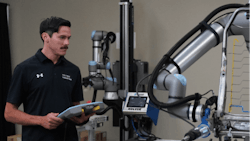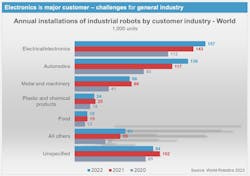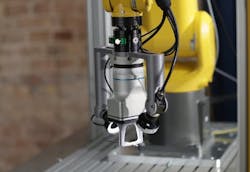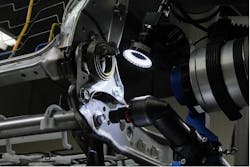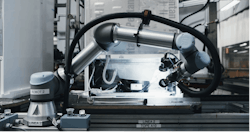Can AI-Powered Robotics Help Overcome U.S. Manufacturing’s Labor Shortage?
Aug. 29, 2024
5 min read
The consequences of labor shortages on the manufacturing industries are severe. Production delays, increased operational costs and diminished capacity to meet market demands are prevalent issues. Companies struggle to maintain productivity, leading to potential losses in revenue and competitiveness. Additionally, the existing workforce faces increased pressure, resulting in higher turnover rates and decreased employee morale.
Automation has long been integral to manufacturing, with robots performing repetitive and hazardous tasks. In recent years, the use of robotics in the U.S. has surged. According to a recent study by the International Federation of Robotics (IFR), the number of industrial robots in operation increased by 14% in 2023, reaching a new peak. In recent years, robots powered by artificial intelligence have emerged as a promising solution to labor shortages by automating complex tasks and reducing reliance on human labor.
Artificial intelligence holds immense potential for robotics, offering numerous benefits in manufacturing. Machine learning enhances process optimization, predictive maintenance and vision-guided robotics. The latter is particularly important in times of labor shortages. AI-guided robots, equipped with cameras and sophisticated software, can react to their environment, exhibiting hand-eye coordination essential for handling high-variance tasks.
Robots powered by AI vision take over tasks that were previously done manually, alleviating workers from repetitive and ergonomically challenging duties. This automation ensures continuous production and high reliability without requiring employees to work unpopular shifts such as nights and weekends or when workers are absent. AI is implemented to address gaps in automation, particularly where traditional solutions struggle with process variances that can cause production halts or quality issues.
AI-powered robots applications
AI-powered robots find applications across industries, including automotive, electronics and white goods, particularly in assembly and end-of-line testing processes, where changing factory conditions occur and robots need to deal with variance in position, form, shape, color, background or light. Key applications include insertion, screwdriving, bolt torquing, picking and placing reflective parts, cable handling, and guiding probes for electrical safety testing and leak detection.
For example, a leading U.S. automotive manufacturer uses AI-vision software for bolt torquing automation. At one of its North American facilities, the automaker assembles automotive seats on rails. During this process, the OEM faces several types of variance. The bolt positions vary due to manual pre-threading, a conveyor system designed for human operation and inconsistent parts from suppliers. Furthermore, unstable lighting conditions pose challenges for traditional vision systems.
This OEM has automated seven bolt torquing tasks previously deemed unfeasible with traditional automation methods by employing cobots integrated with an AI-vision system. Each system saves more than $200,000 per year. The automated systems handle variance in bolt positioning, lighting and inconsistent components from suppliers with a nearly 100% success rate, resulting in improved production throughput and less manual intervention.
Another example involves the leak testing of refrigerators. In the manufacture of refrigerators, a sniffer probe is guided along the pipes at the back of the refrigerator to check whether refrigerant is leaking at the soldering points. Gas leaks as small as 0.5 grams per year must be reliably detected. The position of the pipes and the shape and color of the solder joints are unique for each refrigerator. In addition, the refrigerators to be tested usually move on conveyor belts. All these circumstances prevent automation with conventional automation solutions.
BSH, the European market leader in home appliances and manufacturer of high-end brands, such as Siemens, Bosch and Thermador, uses AI vision to successfully automate different tasks. Thanks to the AI-vision software, the robots at BSH can reliably identify all solder joints and precisely position the sniffer probe thanks to their ability to perceive their environment. BSH has been able to reduce ongoing operating costs, maintenance and troubleshooting. This AI-vision solution is deployed in 24/6 serial production and ensures high quality and absolute process reliability.
Fast implementation
Implementing AI-powered robots is simpler than traditional automation solutions and training AI software is less complex, often requiring only a handful of scenario recordings with a camera. A few hours of training can provide sufficient data for the AI algorithm. Some AI solutions can even train themselves, capturing necessary image data. This eliminates the need to hire computer vision or AI experts. The AI companies' customer success teams can assist with implementation and on-site staff training.
Depending on the complexity of a task, AI-controlled robots can be operational within one to two days. Trained applications can be easily transferred to other robots, enabling quick automation of multiple stations. Existing robots can be retrofitted with AI vision, and retraining for new tasks or setups is quick and straightforward.
Production Advantages
Other advantages of AI-vision software include enhanced operational efficiency and reduced costs, such as:
- Adaptability to variance: AI excels in changing factory conditions, enabling robots to handle variance in position, shape, color, background and light.
- Increased efficiency and stability: AI vision ensures 24/7 operation and consistent production output.
- Flexibility: AI-powered robots are relevant for both discrete and batch manufacturing processes. Their setup can be quickly and economically adapted to process changes. They can be trained away from the line, meaning there is no need to stop production, minimizing downtime concerns.
- Precision and accuracy: AI software achieves millimeter-level accuracy, crucial for tasks like positioning sniffer probes.
- Cost reduction: Automating complex tasks reduces manual labor needs, lowering ongoing operating expenses and maintenance demands.
The use of new technologies can also pay off for recruiting and the satisfaction of the core workforce. For employees, deploying AI-powered solutions in manufacturing means they do not have to do repetitive, unergonomic tasks and night or weekend shifts, ultimately improving work-life balance. AI-guided robots free up the workforce from monotonous, physically demanding tasks and gives them the opportunity to further their education and take on new responsibilities, such as planning and commissioning robot applications.
Matt Jones is vice president of sales and operations at Micropsi Industries.
About the Author
Sign up for our eNewsletters
Get the latest news and updates
